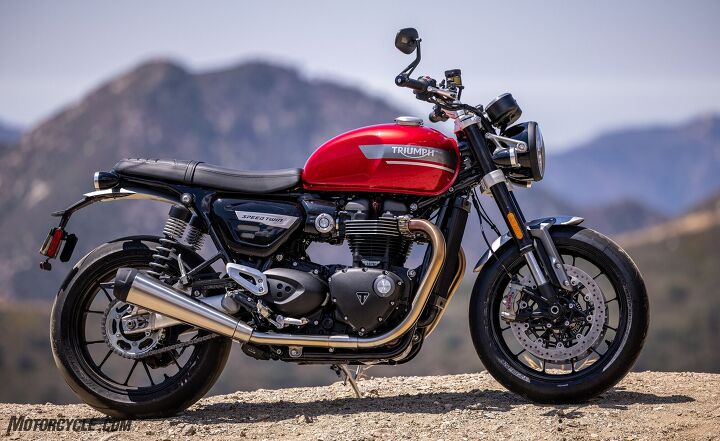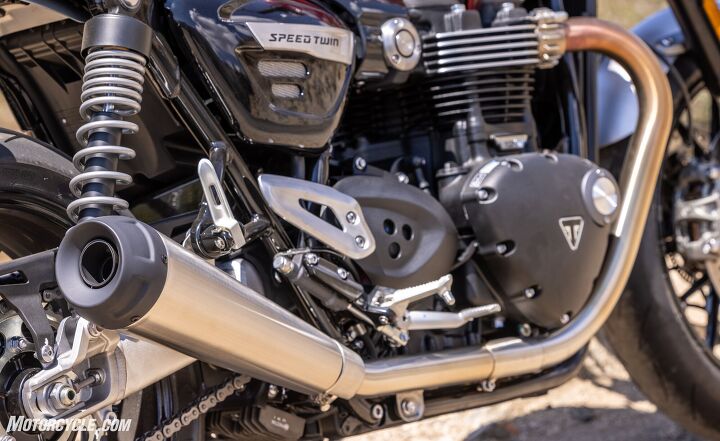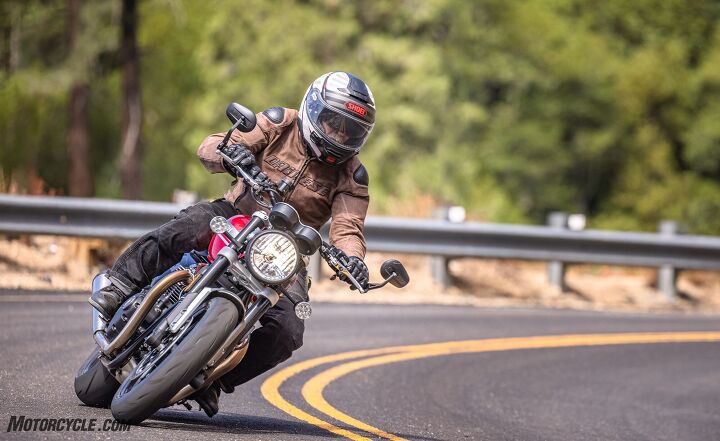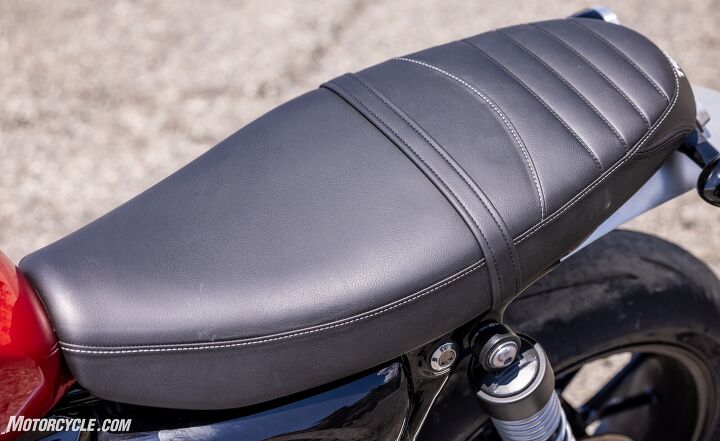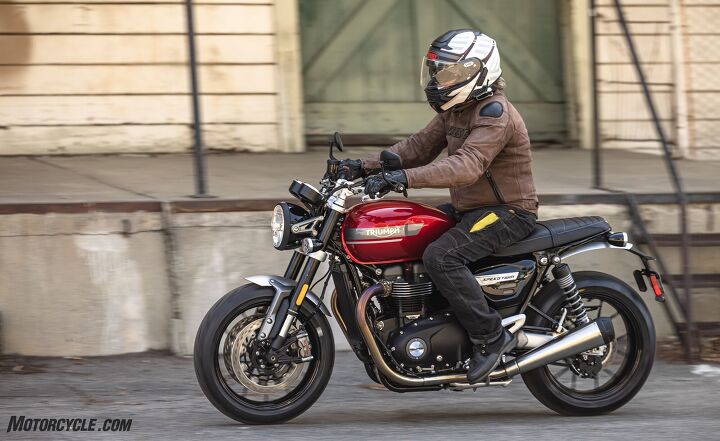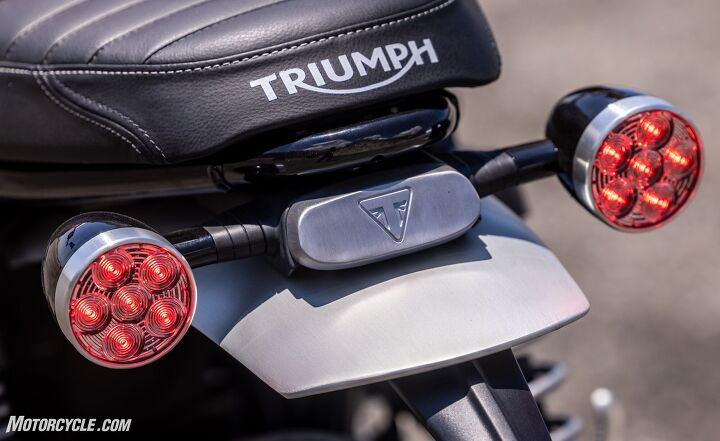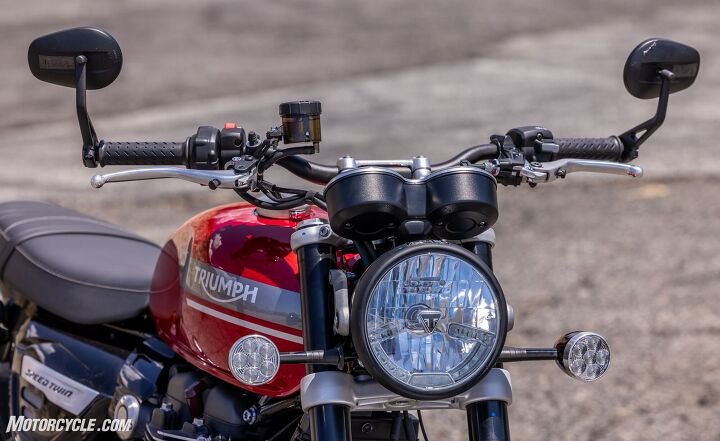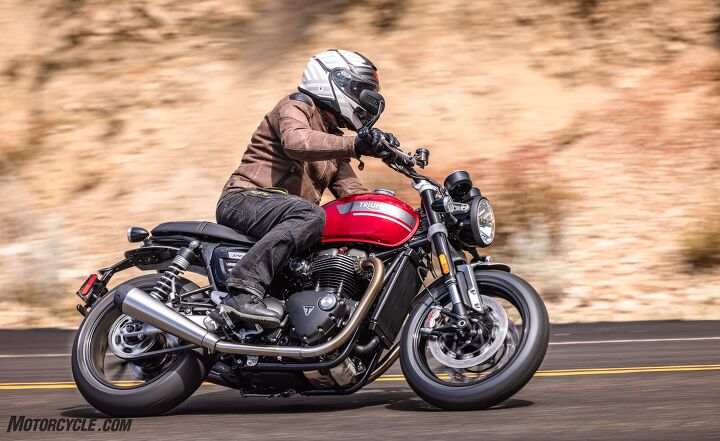Motorsports Racing News & Blog Articles
2022 Triumph Speed Twin Review
2022 Triumph Speed Twin
Editor Score: 89.0%| Engine | 18.5/20 |
| Suspension/Handling | 13.0/15 |
| Transmission/Clutch | 9.0/10 |
| Brakes | 9.0/10 |
| Instruments/Controls | 3.5/5 |
| Ergonomics/Comfort | 9.5/10 |
| Appearance/Quality | 9.5/10 |
| Desirability | 8.5/10 |
| Value | 8.5/10 |
| Overall Score | 89/100 |
It was just about a year ago when we sampled Triumph’s reborn Speed Twin for the first time on home soil, in a two-bike standoff against a way-more-expensive optioned-out BMW R nineT. At the time, we were slightly underwhelmed and had to rate the new Speed Twin second, by a hair.
It was mostly a suspension thing; the Triumph’s old-timey 41mm cartridge fork and twin rear shocks couldn’t compete with the R nineT’s plush, adjustable setup. We expected more from a bike Triumph attaches its most famous name to, maybe unjustifiably, since the original 1938 Speed Twin was itself more a parts-bin lashup designed to save the company from insolvency. It worked, in 1938. But Triumph is nowhere near insolvent now: As a package, the new 2020 ST was a swell motorcycle, but there just wasn’t much component-wise for us to get lathered up about. Then again, maybe Triumph surmised fork gaiters were more appropriate?
2020 BMW R NineT Vs Triumph Speed Twin
Not to worry, we said: There’s bound to be a Speed Twin R or S or RS on the way! Wrong again! But that’s OK, because Triumph went ahead and addressed most of our concerns on the 2022 base model ST, and even lowered the price $499 in the process – now at $12,500. When does that happen? (Our “Red Hopper” paint adds $300, making this one only $199 less than our 2020 ST test unit.)
For 2022, not only do we get a new 43mm inverted Marzocchi fork, those tubes are now brandishing radial-mounted Brembo M50 monobloc calipers squeezing bigger, 320mm discs. Suspension travel remains 4.7 inches at both ends, says Triumph, but the rear shocks are also of “higher-spec” now. New lightweight 12-spoke cast wheels now reside at both ends, wearing also higher-spec Metzeler RR Racetec rubber.
More power…
We didn’t really ask for it, but the changes to make the ST Euro 5-compliant brought us three more horsepower, says Triumph, along with 83 lb-ft of torque lower in the rev-range, at 4,250 rpm. (Our rear-wheel Dynojet 250 had it at 73.8 lb-ft at 4100 rpm for the 2020 model, and 86 horses at just 6600 rpm.)
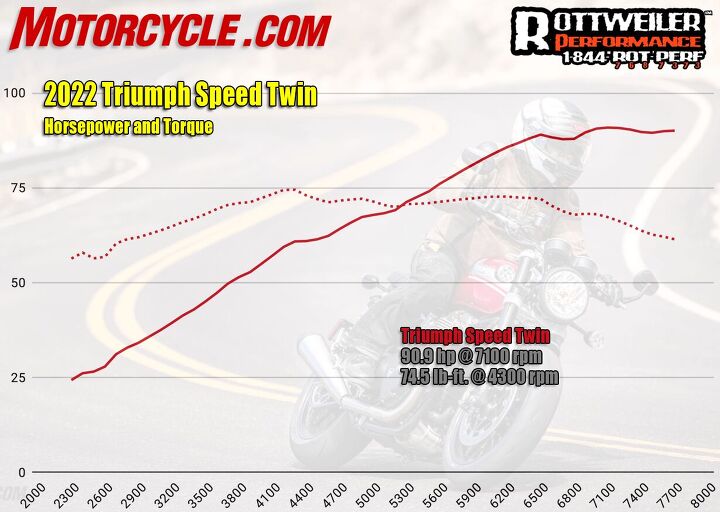
Well, yes and no: We do get 0.7 lb-ft more torque, but it’s 200 rpm higher than before. But we also get 6 more horsepower, and 500 more revs up top which you can actually feel. We’ll take it. With its higher compression ratio and lighter 270-degree crank, the new engine feels peppier all the time.
A 17% reduction in inertia is the product of a new lightweight crankshaft and alternator, which help the engine spool up faster to a redline 500 rpm higher than before (Triumph heard our plea for a bit more top end). New high compression pistons (up to 12.1:1 from 11:1), revised ports and a new cam profile are also part of the performance boost.
You don’t notice the more power much because the torque down low is as nice as it ever was – 74 lb-ft of torque is a lot – but should you take the Twin out on a winding backroad and air it out a bit, you’ll find it has a definite newfound sense of purpose: It exits corners as strongly as before, but now rushes up to the next one even more greedily. The new inverted fork does work better, and adds stability; it and the more powerful front brake encourage the kind of aggression you don’t expect from a bike that looks this way.
Three ride modes – rain, road, and sport – have been “enhanced” for 2022, “adjusting both the throttle response and traction control settings to suit the rider’s preference.” You can’t be spat off if you wind the throttle all the way open on the edge of the tire, unless you turn the tc off. Probably.
It might look retro, but the Speed Twin’s performance really isn’t. It feels like the only thing that would keep it from nipping at the heels of the 900 nakeds we just tested last week is its 480-lb or so weight, and even that’s only 14 pounds heavier than the Kawasaki Z900. In the original Speed Twin’s day, of course, they were all naked bikes – and this one has the same kind of sit-up straight ergonomics as the best of them. (We didn’t get to the scales, but this new ST should be very close to the 478-lb wet weight of our 2020 unit.)
The old twin shocks don’t help much with the sport program either; even with dual-rate springs, they just don’t work quite as well through the bumps and weight transfers as well as a good rising-rate single-shock system, but that seems a small price to pay. Apart from those minor inconveniences, the rest of the Speed Twin is all in for a nice backroad romp – especially if the pavement is smooth. And what’s your big hurry anyway?
Quotidian
Also like the best of the nakeds, the Speed Twin’s great for just hopping on and going wherever you need to go – and bringing a friend is no problem on the long, flat, comfortable seat, which seems lower and easier to straddle than the 31.8 inches Triumph specs.
If you don’t have a friend, a nice topbox, as they used to call them, would be just the thing for carrying your stuff, and at that point the ST is as round-town usable as a nice maxi-scooter. Also way more worthy of respect from the hoi polloi; the Twin’s admirers range from members of the GPTB to callow youths of most major sexual prefixes.
The slip/assist clutch is easy to work with two fingers and both levers are adjustable; the 6-speed gearbox is low-effort and foolproof. The bar-end mirrors are great, with a wide view of what’s behind that’s worth the slight extra care needed not to whack other peoples’ mirrors when the going is tight. In general, having 74 lb-ft of torque to work with makes zipping through traffic and around town a breeze; with the slightest throttle opening, everything’s back there with your 270-degree High Power parallel twin dual-exhaust burble. This bike would be a breeze to learn to ride on for non-idiots; it’s a nicer, more powerful version of the Trident that won our other recent naked-bike shootout.
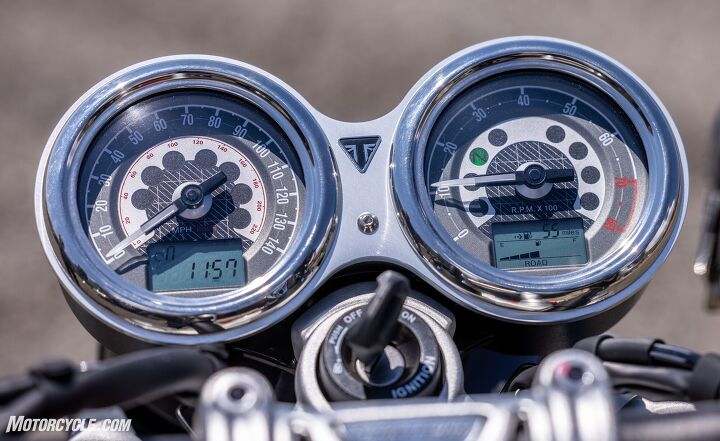
The usual info is available in the LCD windows, much of it too small to read at speed, but none of it’s all that important anyway except the gas gauge. Triumph claims 46 mpg; we averaged 40, but our bike had 0 miles on it when we picked it up.
At 80 mph on Ike’s infrastructure, we’re turning around 4300 rpm on the ol’ tachometer, which is right at the torque peak, with a trace of non-objectionable big-twin rumble sneaking through the aluminum fatbar. From that speed, the pair of 600 cc cylinders generates speed easily and serenely, up to and well beyond the ton – and feels more planted through rain grooves than the previous version, though again, the rear end can get pretty choppy over busted-up pavement. (Could be a great excuse to buy your SO some swell piggyback Öhlins as a gift at the next occasion, since they’re the one who rides back there!) That plantedness could be down to the new Metzeler Racetec tires, which are fine, but slightly weird that you’re left with inch-wide chicken strips on the front when you’ve used up nearly all the rear’s tread?
Maybe it’s not supposed to be a travelling motorcycle, but the big Twin cruises nice enough I wouldn’t mind going places on it; for me, leaning into the handlebar and resting my feet on the passenger pegs results in smooth sailing. Which makes it doubly a shame there’s no cruise control and none available as an accessory, especially given that the Scrambler 1200 sister ships, XC and XE, both come with CC. In fact, we said last year we’d probably buy the XC over the Speed Twin for that reason alone. This year, it’s a closer contest…
Easy on the Orbisons
The 2020 Speed Twin was swell to look at, but the new one’s even prettier – not just because of the up-spec fork and front brakes, but also because Triumph’s given the new bike brushed aluminum front and rear fenders on new mounts, brushed aluminum side panel finishers and heel guards, anodized headlamp mounts, the brushed Monza fuel cap, clear anodized aluminum swingarm…
Not only have we got more power and 500 more rpm to play with, that new Euro 5 engine emits less pollutants, and Triumph also touts: “As with all of the models in Triumph’s Modern Classic range, the cost of ownership is kept low thanks to the high first major service interval of 10,000 miles / 16,000 kilometres.”
Compared to that first 2020 Speed Twin, this one’s definitely a step in the right direction for anybody who’s interested in going faster and stopping and handling better – not to mention looking at parked. (If you’re a fan of fork gaiters, it’s time to drive a hard bargain on the first-gen ST.)
Austin Powers or James Bond?
It’s a little of both: All that power and a dialled chassis mean this retro is eminently capable of playing the lead role of a really good performance bike. But the ’60s styling touches combined with the modern components, LED lighting, low maintenance requirements, etc., make it a retro-modern platform you can just roll around on, in your fake teeth and open-faced helmet, and laugh at the world. It’s groovy.
| 2022 Triumph Speed Twin | |
| + Highs More power, better handling Great on backroads and around town Sleeper performance | – Sighs No cruise control is mean and stupid A bigger gas tank would be better Cruelty to current owners to reduce the price |
|
In Gear
|
| 2022 Triumph Speed Twin Specifications | |
|---|---|
| Type | Liquid-cooled SOHC, 270°-crank parallel Twin; 4 valves/cylinder |
| Displacement | 1200 cc |
| Bore x Stroke | 97.6 mm x 80 mm |
| Compression Ratio | 12.1:1 |
| Maximum Power | 90.9 hp @ 7100 rpm (measured, rear-wheel, Dynojet 250) |
| Maximum Torque | 74.5 lb-ft @ 4300 rpm (measured, rear-wheel, Dynojet 250) |
| Fuel System | Multipoint sequential electronic fuel injection |
| Exhaust | Brushed stainless steel 2 into 2 exhaust system with twin silencers |
| Final Drive | O-ring chain |
| Clutch | Wet, multi-plate torque assist clutch |
| Gearbox | 6-speed |
| Frame | Tubular steel, with steel cradles |
| Swingarm | Twin sided aluminum |
| Front Wheel | Cast aluminum alloy, 17” x 3.5” |
| Rear Wheel | Cast aluminum alloy, 17” x 5.0” |
| Front Tire | 120/70 ZR17 |
| Rear Tire | 160/60 ZR17 |
| Front Suspension | 43mm inverted Marzocchi fork, no adjustments, 4.7 in. (120mm) travel |
| Rear Suspension | Twin coil-over shocks, adjustable spring preload, 4.7 in. (120mm) rear-wheel travel |
| Front Brakes | Two 320mm discs, Brembo M50 4-piston radial monobloc calipers, ABS |
| Rear Brakes | 220mm disc, Nissin 2-piston floating caliper, ABS |
| Instruments | Twin dial analogue speedometer and tachometer with LCD multi-functional displays |
| Length | 82.6 in. (2099mm) |
| Width (Handlebars) | 30.6 in. (778mm) |
| Height Without Mirrors | 43.2 in. (1097mm) |
| Seat Height | 31.8 in. (809mm) |
| Wheelbase | 55.6 in. (1413mm) |
| Rake | 22.3° |
| Trail | 3.6 in. (91.5mm) |
| Wet weight | 476 lbs (claimed; the 2020 Speed Twin weighed 478 lbs on MO scales) |
| Fuel Tank Capacity | 3.8 gal (14.5 litres) |
| Fuel Consumption | 46 mpg (5.1 litres / 100 km), claimed; MO observed: 40 mpg |
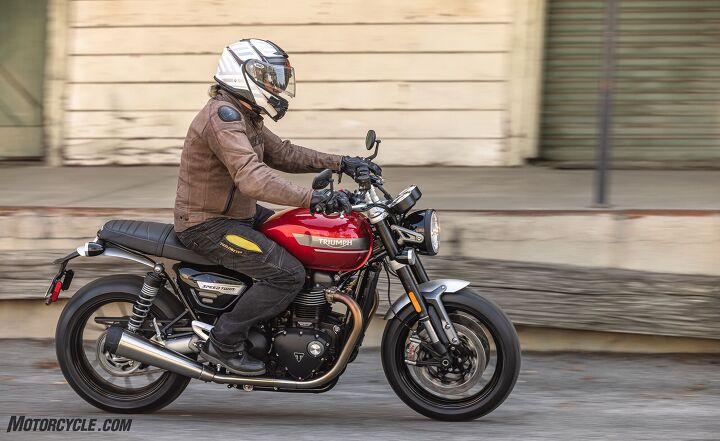
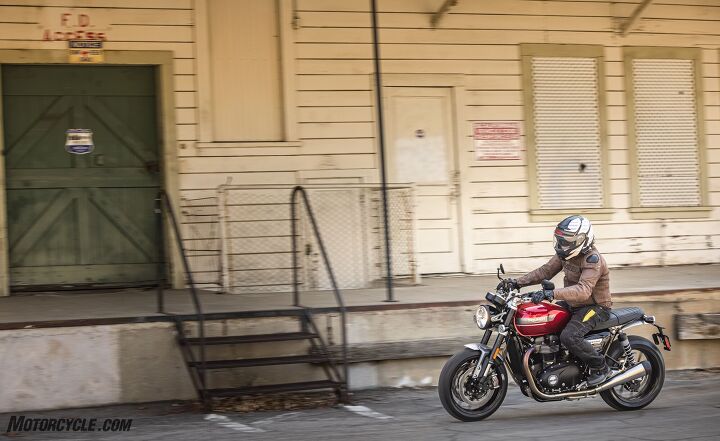
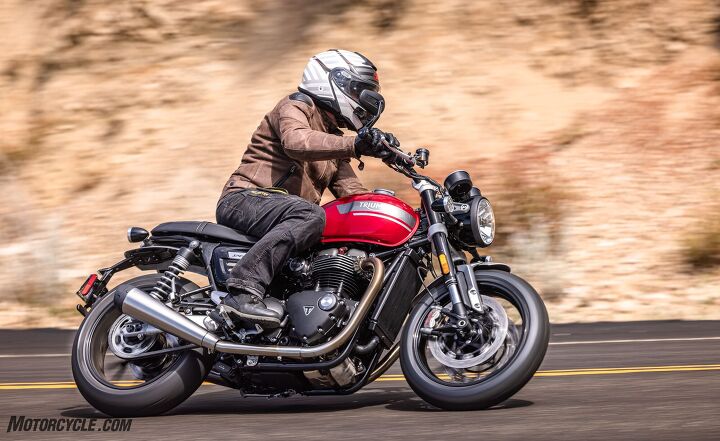
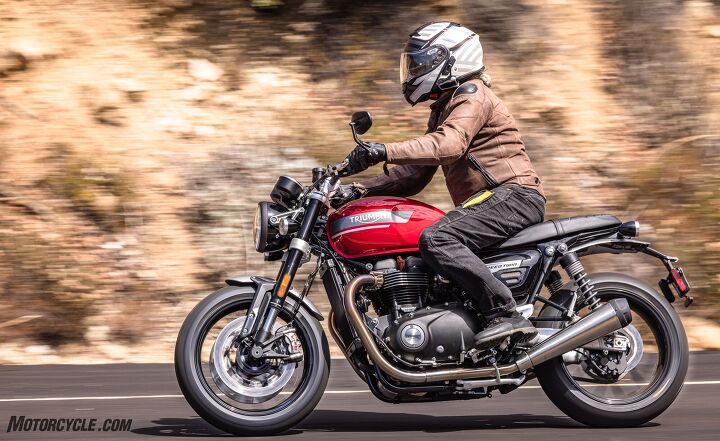
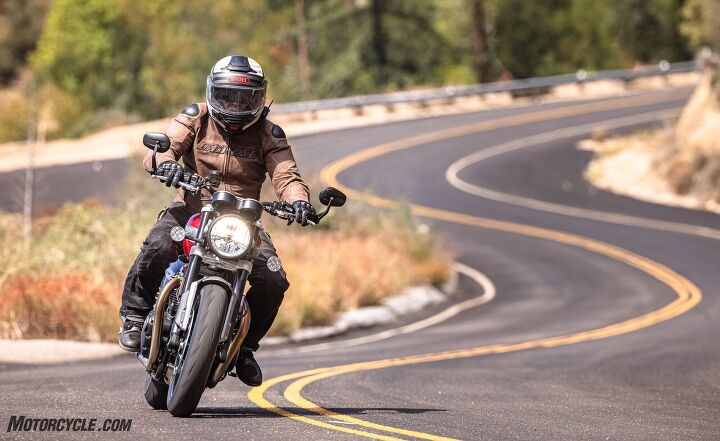
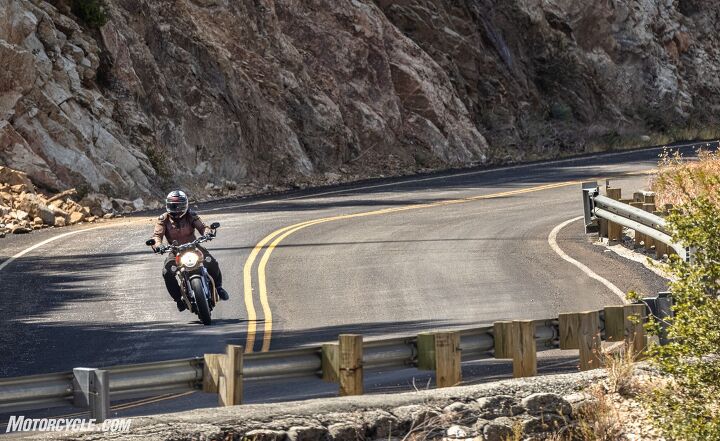
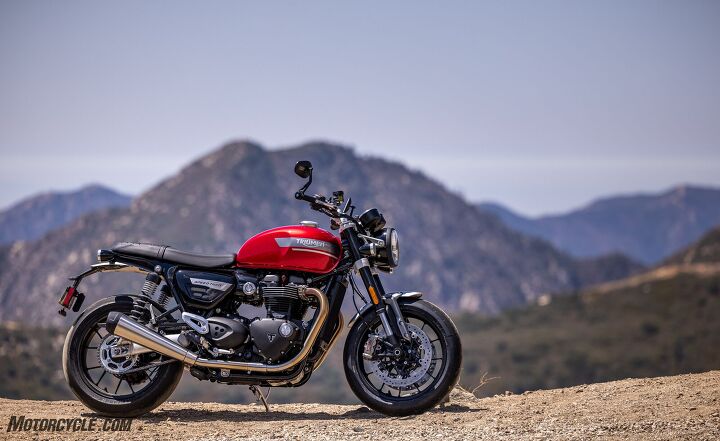
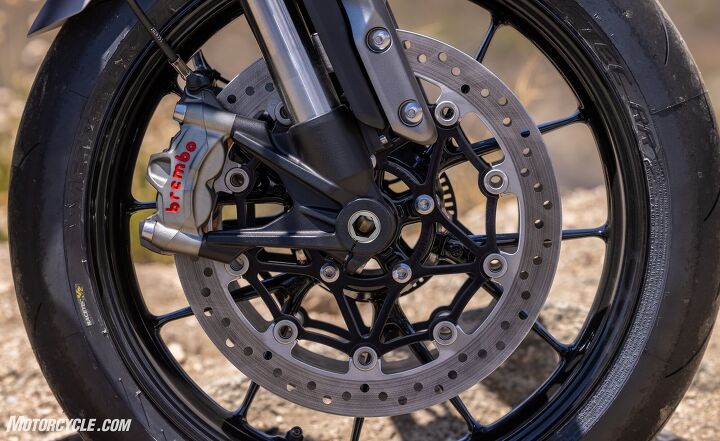
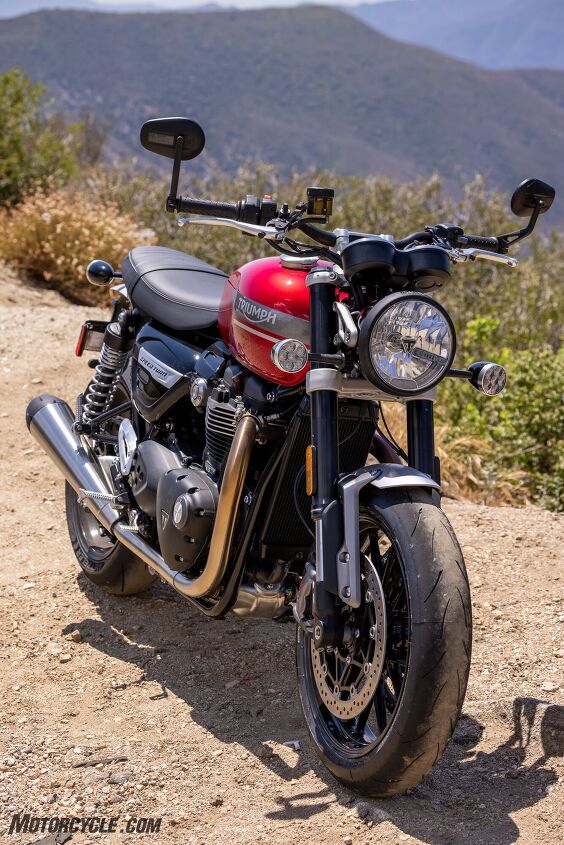
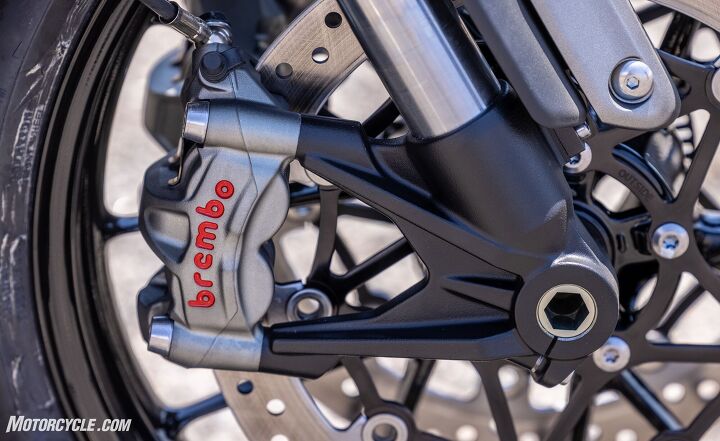
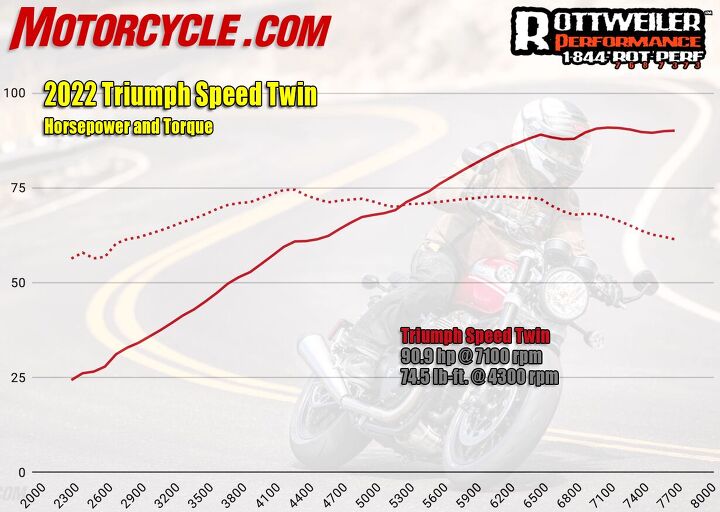
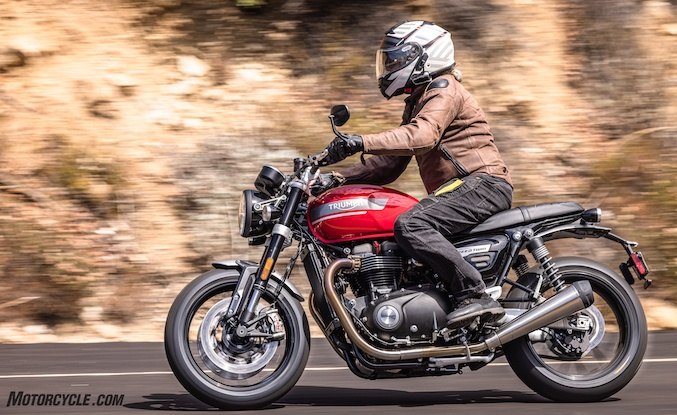
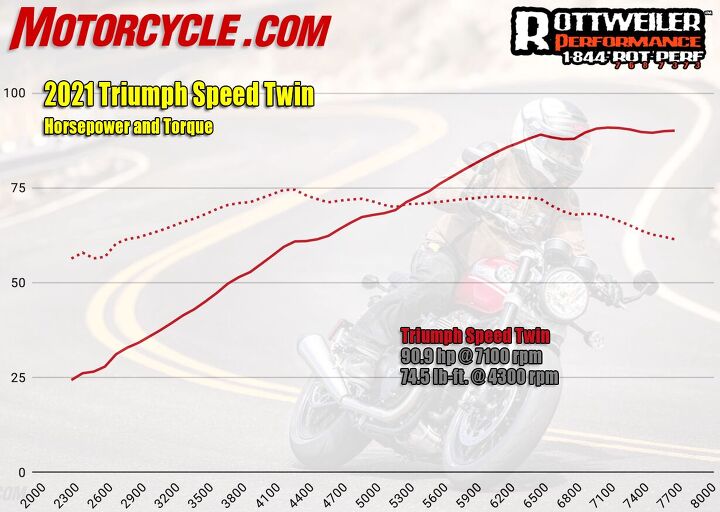

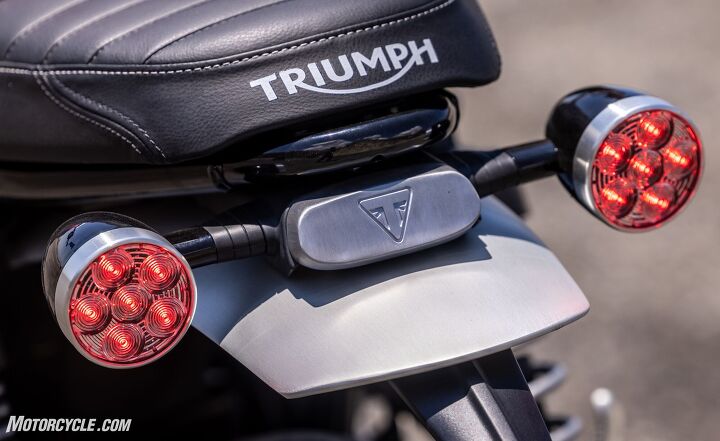
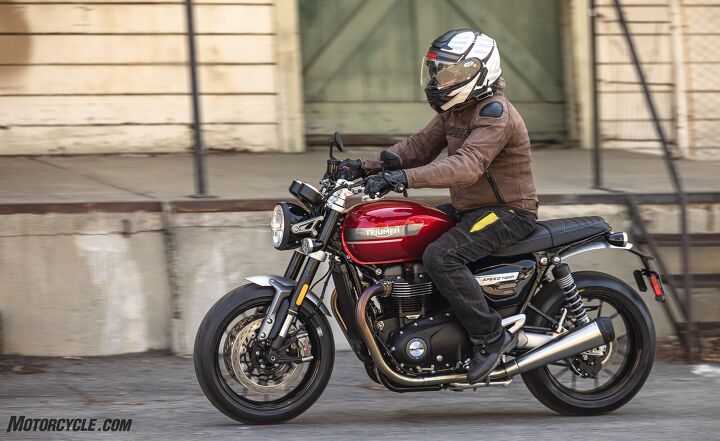
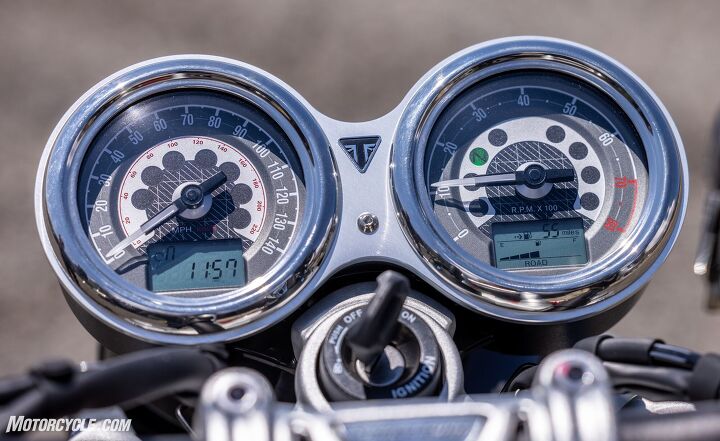
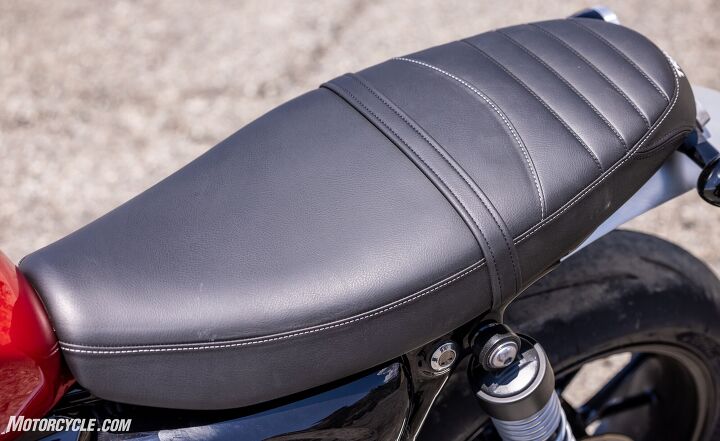
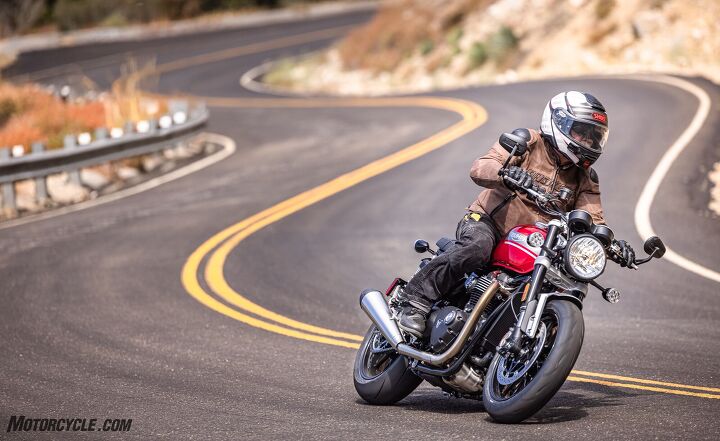
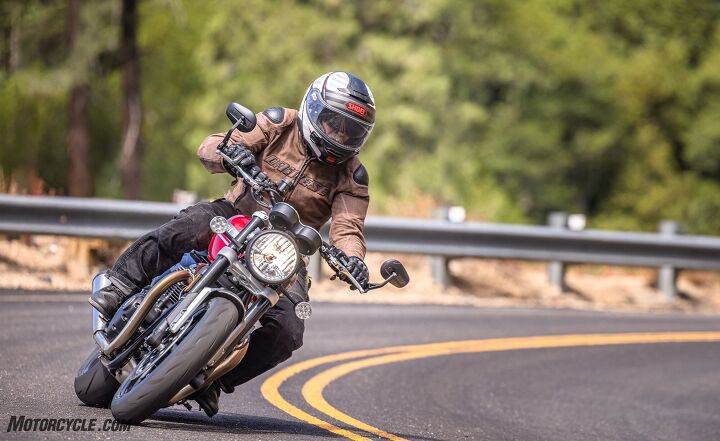
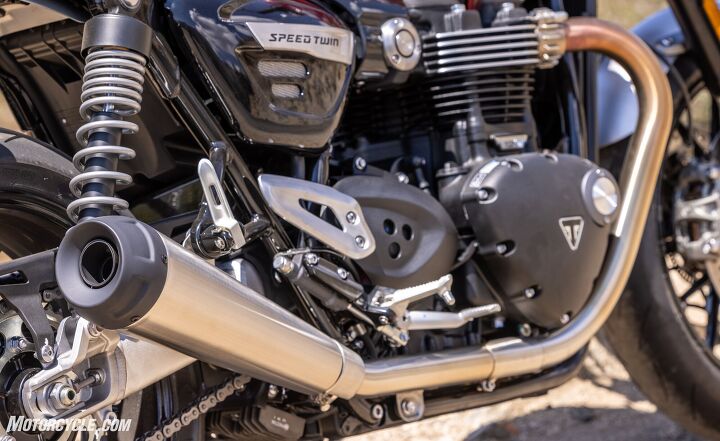
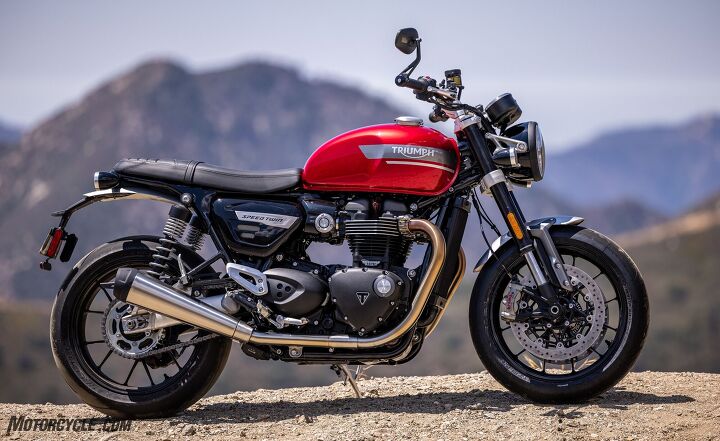
We are committed to finding, researching, and recommending the best products. We earn commissions from purchases you make using the retail links in our product reviews. Learn more about how this works.
Become a Motorcycle.com insider. Get the latest motorcycle news first by subscribing to our newsletter here.
The post 2022 Triumph Speed Twin Review appeared first on Motorcycle.com.
Copyright
© Motorcycle.com


